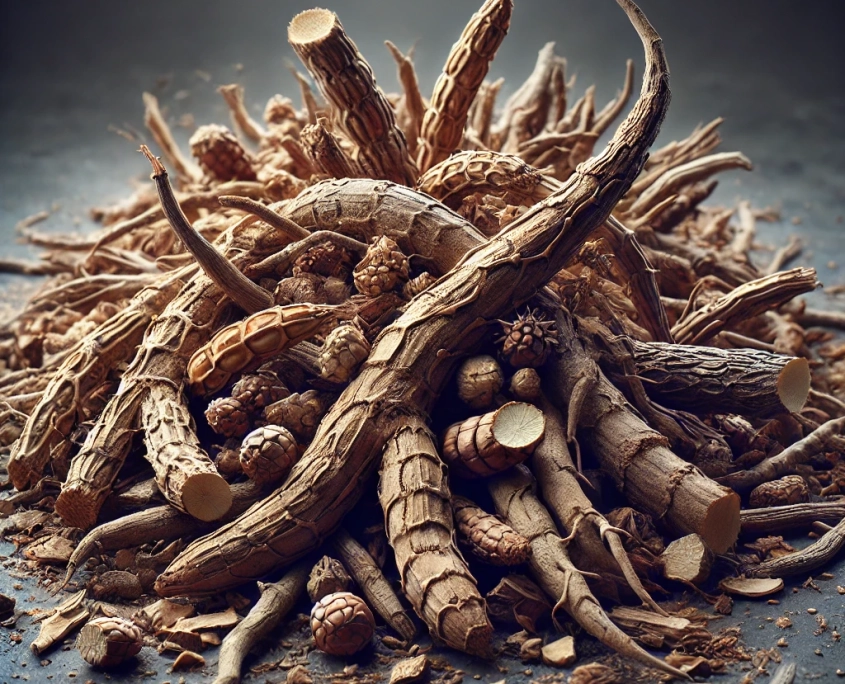Tongkat Ali: A Comprehensive Overview of Its Therapeutic Potential and Traditional Uses

Tongkat Ali, scientifically known as Eurycoma longifolia, is a flowering plant native to Southeast Asia, including Malaysia, Indonesia, and Thailand. Commonly referred to as “Malaysian ginseng” or “longjack,” Tongkat Ali has been traditionally used for its reputed health benefits, particularly in enhancing male vitality, increasing energy levels, and promoting overall well-being.
Botanical Overview: Tongkat Ali belongs to the Simaroubaceae family and is a tall, slender shrub that can reach up to 10 meters in height. The plant thrives in the rainforests of Southeast Asia, where it has been traditionally harvested for its roots, which are rich in bioactive compounds. The roots of Tongkat Ali are typically boiled to make a bitter decoction, believed to possess various medicinal properties.
Active Compounds: The therapeutic potential of Tongkat Ali is attributed to its diverse array of bioactive compounds, including:
- Quassinoids: The primary active constituents in Tongkat Ali are quassinoids, particularly eurycomanone, eurycomanol, and eurycomalactone. These bitter compounds are known for their antiparasitic, anti-inflammatory, and aphrodisiac properties.
- Alkaloids: Tongkat Ali contains several alkaloids, such as beta-carboline, which exhibit neuroprotective and mood-enhancing effects.
- Saponins: These compounds contribute to the herb’s adaptogenic properties, helping the body to cope with stress and fatigue.
- Eurycolactone and Eurycomalactone: These are specific compounds unique to Tongkat Ali, contributing to its testosterone-boosting and energy-enhancing effects.
Health Benefits:
- Enhancement of Male Sexual Health: Tongkat Ali is widely recognized for its ability to boost testosterone levels, improve libido, and enhance male fertility. Studies have shown that the herb can increase sperm count and motility, making it a popular natural remedy for male reproductive health issues.
- Energy and Stamina: Traditionally used as a tonic to increase energy levels, Tongkat Ali is believed to help combat fatigue and improve physical endurance. This effect is partly due to its adaptogenic properties, which support the body’s ability to resist physical and mental stress.
- Anti-Inflammatory and Antioxidant Effects: The quassinoids and saponins in Tongkat Ali exhibit significant anti-inflammatory and antioxidant activities, helping to reduce oxidative stress and inflammation in the body. This makes the herb beneficial in managing conditions related to chronic inflammation, such as arthritis and cardiovascular diseases.
- Cognitive Function: Tongkat Ali has also been studied for its potential to enhance cognitive function, particularly in improving memory and reducing anxiety. The alkaloids in the herb are believed to play a role in modulating neurotransmitter activity, which may contribute to its neuroprotective effects.
- Muscle Strength and Athletic Performance: Emerging research suggests that Tongkat Ali may support muscle strength and athletic performance by promoting lean muscle mass development and reducing body fat. This has made it a popular supplement among athletes and bodybuilders.
References:
- Ang, H. H., Lee, K. L., & Kiyoshi, M. (2004). Eurycoma longifolia Jack enhances sexual motivation in sexually naive male rats. Archives of Pharmacal Research, 27(4), 471-474.
- Talbott, S. M., Talbott, J. A., George, A., & Pugh, M. (2013). Effect of Tongkat Ali on stress hormones and psychological mood state in moderately stressed subjects. Journal of the International Society of Sports Nutrition, 10(1), 28.
- Thu, H. E., Mohamed, I. N., Hussain, Z., & Shuid, A. N. (2016). Eurycoma longifolia as a potential adoptogen of male sexual health: A systematic review on clinical studies. Chinese Journal of Natural Medicines, 14(1), 55-60.
- Kiyoshi, M., Akira, M., & Hideo, K. (2002). Effects of Eurycoma longifolia Jack on the spermatogenesis and level of gonadotropins in rats. Phytomedicine, 9(3), 245-250.
